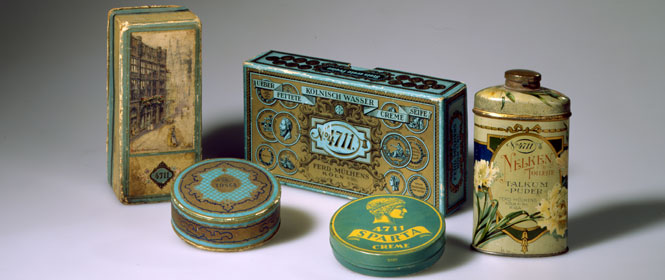
4711 – Refreshes and calms the nerves
For some, it’s just a number. But for others, the very mention of ‘4711’ conjures up a palpable whiff of that familiar tangy fragrance. It’s no secret that opinions are sharply divided by the scent known as ‘Echt Kölnisch Wasser’, or ‘Original Eau de Cologne’. Yet the perfume still enjoys great popularity today. Despite keen interest in the famous brand, the history of this classic perfume remains little known.
The origins of ‘4711’ can be traced back to the year 1792, when businessman Wilhelm Mülhens was given the recipe as a wedding present from Franz Maria Farina, a Carthusian monk. Opinions differ on how much truth there is to this founding legend, but it is a fact that, beginning in 1799, Mülhens sold his ‘aqua mirabilis’ – healing miracle water – as ‘Cologne Water’, marked with the words: ‘Franz Maria Farina – Klöckergasse No. 4711 in Cöln a. R.’. Although the words served as a kind of seal of quality, they hardly constituted a legal claim to the trademark, for at the time there were over fifty producers making use of the name ‘Farina’. Decades later, as a result of legal disputes with the Farina family, Mülhens’s grandson would introduce a new product description: ‘Eau de Cologne Perfumery Factory Glockengasse 4711, opposite the Stagecoach of Ferdinand Mülhens’. In 1875, ‘4711’ was finally registered as a trademark in Germany’s commercial register.
The Scent of Reform
But how did the Eau de Cologne get its emblematic numerical trademark? It all goes back to the time of the French occupation of 1796, by which time French expansion into Germany west of the Rhine had extended to the city of Cologne. Territorial reorganization brought modern French administrative techniques to the old cathedral city, specifically what were known as ‘conscription numbers’. This new practice of continuous house numbering was introduced to end the confusing disorder of house-naming and ultimately to facilitate the quartering of troops. Previously, buildings were known by names only – a stranger to the town might be told to go to ‘House of the Bear’, then on to the ‘House of the Whale’, until he finally arrived at the ‘House of the Ox’. Which may sound like fun to us now, but must have presented considerable disadvantages in everyday life. It was rational enough to introduce a comprehensible numbering system as an aid to orientation, and Wilhelm Mülhens’s building in Glockengasse was given the number 4711. Years later, the address changed again when the continuous numbering system was abolished, replaced by a street-based system, but the name of the ‘Original Eau de Cologne’ remained unchanged. So ironically enough, a classic German perfume owes its name to the French.
From Elixir to Aromatherapy
Incidentally, the French took a close interest in the secret recipe of the miracle water from Cologne. In 1810 Napoleon Bonaparte himself ordered the disclosure of the recipes of all internally administered (!) pharmaceutical products, the category to which Eau de Cologne originally belonged. To evade the order and protect the trade secret, ‘4711’ was hastily redesignated as a remedy for external use only. Where previously it had been advertised as a health drink, to be taken straight or mixed with wine, now the manufacturer declared it a stimulating tonic, to be used for aroma-therapeutic purposes.
Still a Secret Recipe
The precise combination of ingredients and essential oils that lend the perfume its unmistakable scent remains a closely-guarded secret today, although we know the main ingredients include bergamot, lemon, orange, neroli, petitgrain, lavender, and rosemary. It is also worth mentioning the design of its unique flacon, known as the Molanus Bottle. Named after its inventor, Peter Heinrich Molanus, the container is a major contributor to the perfume’s brand recognition. As well as its aesthetic function, the unusually shaped bottle is also highly practical for storage and transport, while the striking arch in the bottle’s neck helps the aromatic release of the ingredients, intensifying the olfactory experience.
Over the years, the range of ‘4711’ products has grown significantly, with a range of soaps and perfumes making new use of the sharp, refreshing scent of ‘Original Eau de Cologne’. Some of these products can be found in the collection of the Deutsches Historisches Museum, for example ‘Nelken Toilette Talkum Puder’ (Nettle Toilette Talcum Powder) and ‘Sparta Crème’. In 2004, the DHM exhibition ‘Strategies of the Art of Advertising, 1850–1933’ presented a fascinating selection of these products, including a number of powders and creams, as well as a flacon of original eau de cologne from the house of ‘4711’.